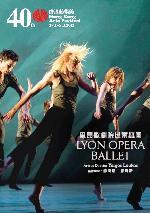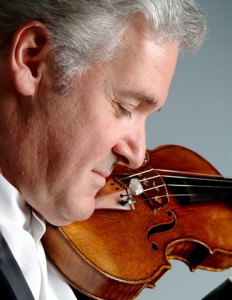 |
George Balanchine once said “Dance is music made visible.” “What?! Am I supposed to be listening or watching or what?” exclaimed a commoner, gesturing bewilderedly and protesting fervently. A pseudo-artist paused to contemplate on this seemingly illogical statement that mixes up an ear with an eye. But a real artist understood immediately and thoroughly where this led to- integrated arts, also my vision for the future of artistic development.
The foremost choreographer of contemporary ballet used five words to span three different art forms: dance, music and visual art. Much in accordance to his precept, I was enabled to “see the music and listen to the dance” at his ballet Concerto Barocco restaged by Lyon Opera Ballet. The troupe performed at the Cultural Center in February 2012 as part of the Hong Kong Arts Festival.
Set to the Concerto for 2 Violins in D Minor by Johann Sebastian Bach, the ballet portrays the score, in which two violins converse, with two prima ballerinas incarnated to dialog with each other. It was created for the American Ballet Caravan in 1941 and entered the repertory of Lyon Opera Ballet in 2011.1 Dressed in Balanchine’s signature white leotards set against a light blue background, Karline Marion and Julia Carnicer used their bodies to form complementary shapes, sometimes entwined, sometimes magnetized, sometimes bounced apart; they drew lines, circles, and spirals as if to design a maze. Through their impersonation along with eight corps de ballet, the performance made it possible see the music sheet being written with notes constructing the concerto piece by piece. From the slow À la seconde and Adagio, progressing to Balancé, then quieting down to effacé, Bach’s crotchets and quavers could be seen springing up the staves one after another. As the pointed shoes hit the wooden stage, it even sounded as if Balanchine were adding his finishing touch to Bach’s concerto.
“The dancers do not mirror the music, they draw a danced picture of the music.” Balanchine pointed out. The master has always admired huge compositions by corps de ballet in geometric figures that form, break up, and become entangled; as well as the alignments of the ballerinas in columns, whose perfect symmetry is reminiscent of the façade of a classical monument. “The ballet tries to interest the audience not only by its dancing, but its treatment of the music, just as Baroque art and architecture interested people, not because of their subjects, but because of the decorative treatment that embellished those subjects.”1
Church, to be precise. Bach’s concerto is considered among the best examples of Baroque period during which religious architecture flourished. It is believed that the “visuality” of Bach’ music is so potent that it can evoke an architect within the audience. The links between the music score and the church’s building blocks are created by the mathematics of sound. In an audio visual installation called Sketches of Utopia, Bach’s mass was illustrated by interactive software that selected 3D forms which were added, moved and changed to create a dynamically animated structure. Through deconstruction and reconstruction, these images served as visual interpretation to the Baroque Utopia of a harmonious universe of mathematically ordered sounds and forms.2 Most importantly, the calligraphic imageries in relation to the entire architecture paralleled the relationship between individual notes and the entire concerto.
Concerto Baroccofollows a musical structure full of fugal imitation and much counterpoint. Therefore, upon hearing the music, audience is naturally stimulated with images of perfectly symmetrical structures similar to the ones deployed to elaborately decorate Baroque-style churches. This was the exact experience of watching Balanchine’s ballet re-enactment, only that the brushstrokes were substituted by ballerinas’ long necks, slender limbs and perfectly arched feet, as they stretch and withdraw, swing and turn, tip and slide; their grouping and configuration honor the concerto with close attention to its rhythms and dynamics. Thus the dancers depict varied shapes and complex layers in which Baroque churches were lavishly adorned. Soon the patterns evolved into a maze; in and out of it were the two prima ballerinas led by a male dancer as if playing hide and seek. I could almost see him lifting them up to touch the domes, running through the facades, hiding them in the double towers, looking out from the irregular-formed windows before finally catching them in the annex.
Most unfortunately, however, this “church” formed by Lyon Opera Ballet didn’t quite live up to the Baroque aesthetics of harmony and balance. At one point the eight corps de ballet were divided into two groups of four which crossed the stage diagonally. From my VIP seat right in the middle, I could clearly see the left line shorter than the right: the spacing between dancers and angle they were facing were not the same as their counterpart on the right. As a result, the two groups formed two asymmetrical lines. Alas! Even if the sea in Lyon produces some fine fiddler crabs, the troupe must have offended both Balanchine and Bach by laying out their corps de ballet in the same shape as the crabs’ claws; it simply goes against the two masters’ aesthetics of balance and harmony.
Nevertheless, the masters would be happy that I was indeed enabled to “see the music and hear the dance”. This is the fruit of Balanchine’s choreography which grew from his mastery of multiple art forms- in addition to dance.
First, music. Son of a composer, Balanchine began piano lessons at five, then studied piano and music theory, including composition, harmony and counterpoint.3 It gave him the ability to make piano reductions of orchestral scores, an invaluable aide in translating music into dance.4
Secondly and more importantly, visual art. His defining ballet Apollon saw him fluidly transforming sound into movement, turning ballet into a visualization of the music. The dance and the score blended into each other “like coffee with milk” as he described. This became one of his most innovative works where classical ballet integrated with Greek mythology images.1 Not contented with the stage as his only canvas, he went on to explore television. He’d personally supervise every shot, in some cases even revising steps for greater effectiveness on screen- demonstrating fluidity across music, dance and moving images.5
From visual arts to music to dance, Balanchine managed to integrate his talent for different art forms in the creation of ballet Concerto Barocco. With his music background, he effectively turned the ballerinas’ feet into the violinists’ fingers, and the stage into an imaginary violin. Upon their small and metrically rhythmic steps, the ballerinas’ flats hit the floor and produced a string of notes that could almost be seen organically evolving into Concerto Barocco. At the same time, he manipulated the corps de ballet by their spatial design, flow, transition and formation to portray vividly a Baroque-style church. It is the solid mastery of multiple disciplines - and integration between them, that made Balanchine the preeminent choreographer who broke new grounds for contemporary ballet. Fluidity across art forms allows artists’ energy to peak.
It is no coincidence that my own vision for “artist of the future” looks toward the same direction. Although arts are traditionally studied as individual disciplines, it is my philosophy that various art forms are inherently connected and serve the same ultimate purpose; hence the concept of “integrated arts”. By stimulating different human senses- eyes with paintings and ears with music for instance, the integration of multiple art forms accomplishes an artist's mission - beyond aesthetic enjoyment, of educating and inspiring people. An artist of the future should have broader perspective on how arts can be integrated for something more creative and innovative. Only then can he reach a higher level of artistic accomplishment than being well-versed at one individual art form. Thankfully Balanchine with his choreography has served as a living example of this vision of integrated arts.
Similarly the notion of “artistic utopia” was once described by artists thus: where there will no longer be any sort of hierarchical relationship between different art forms; they become all equal, co-existing and integrated entities in space and time. As the two prima ballerinas dialoged with each other to the two violins, I could almost hear Bach and Balanchine conversing; I could almost see Bach, in composing this piece for two violins, yearning for his collaborator, be it Balanchine or Francesco Borromini or Pietro da Cortona. Together they’d take one step closer to Utopia.
References:
1. Hong Kong Arts Festival, 2012, http://www.hk.artsfestival.org/media/pdf/HP_LyonOperaBallet.pdf
2. Michael Gibb, 2011, http://wikisites.cityu.edu.hk/sites/newscentre/en/Pages/201102181657.aspx
3. Wikipedia, 2012, http://en.wikipedia.org/wiki/George_Balanchine
4. The George Balanchine Foundation, 2002, www.balanchine.org
5. New York City Ballet, http://www.nycballet.com/company/history/balanchine.html
6. Mary Fleischer, 2007, Approaches to Collaboration: Choreographers and Visual Artists (conference transcript)
本網站內一切內容之版權均屬國際演藝評論家協會(香港分會)及原作者所有,未經本會及/或原作者書面同意,不得轉載。









